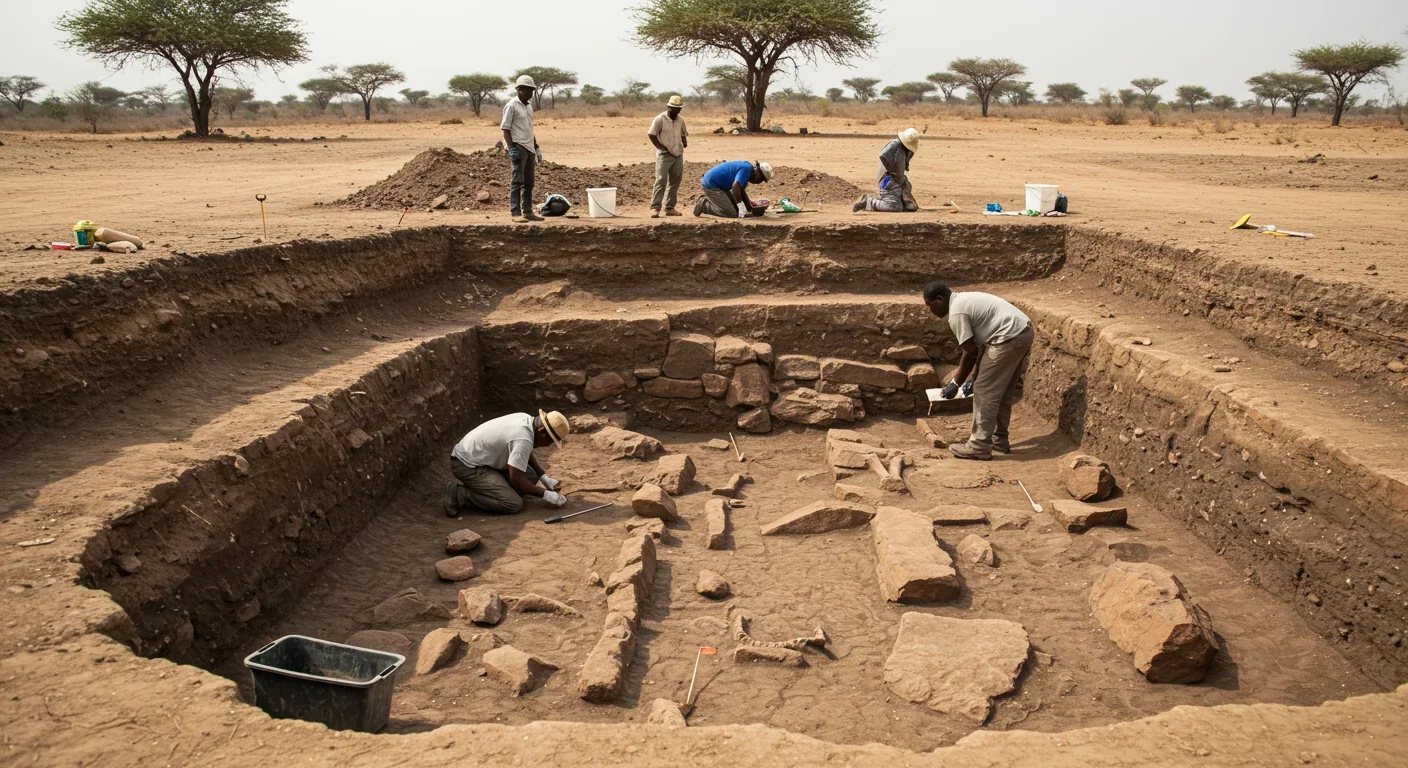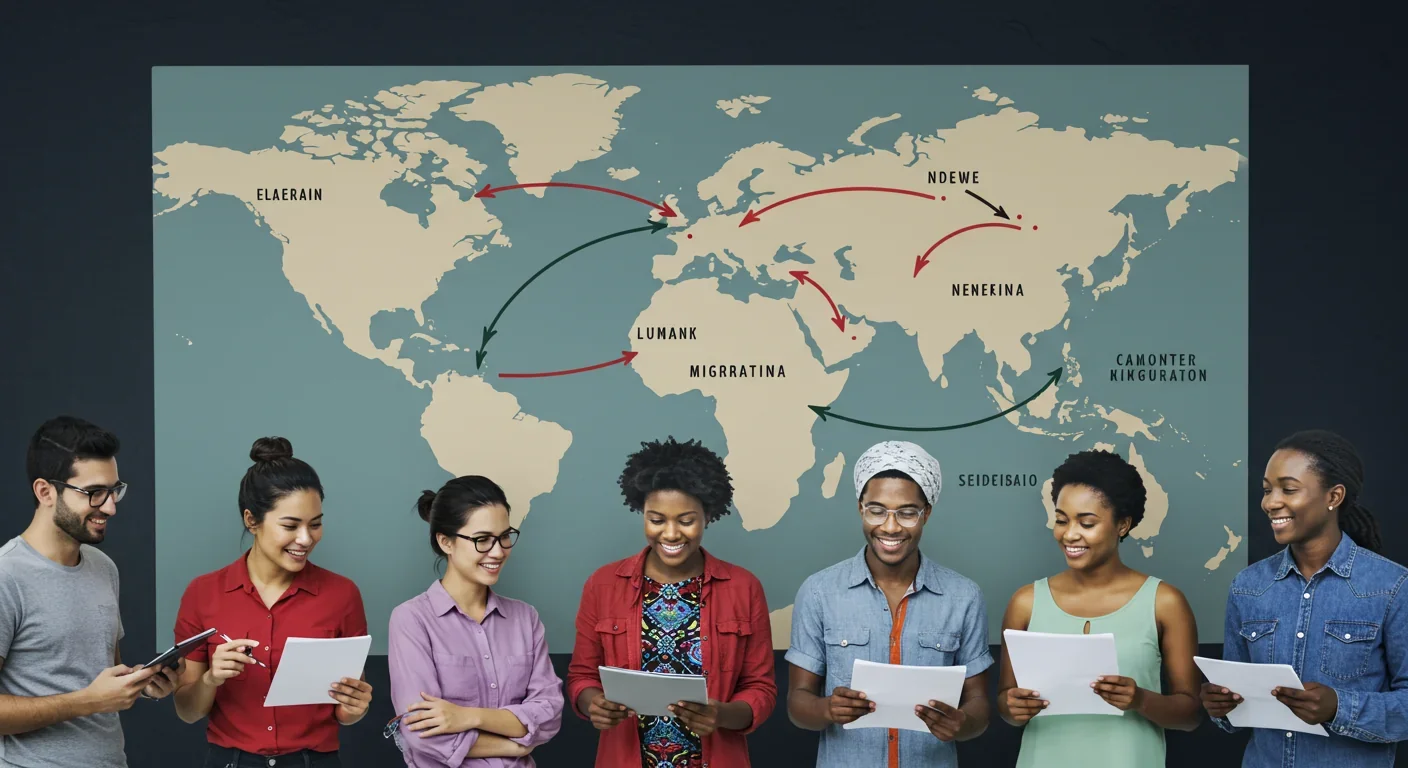Why Your Brain Sees Gods and Ghosts in Random Events

TL;DR: Humanity's 300,000-year journey from Africa to every continent reveals a story of adaptation, innovation, and interconnection, written in DNA, stone tools, and languages that reminds us migration and mixing have always defined the human experience.

Every person alive today carries within their DNA the story of an epic journey. A journey that began in Africa some 300,000 years ago and eventually reached every corner of the planet. But this wasn't a single exodus with a clear route. It was a sprawling, unpredictable odyssey shaped by climate shifts, technological breakthroughs, and pure human curiosity. The evidence for this remarkable migration lies scattered across continents in fossilized bones, stone tools, genetic markers, and even the languages we speak.
Africa isn't just where humanity began. It's where we became human. Around 300,000 years ago, Homo sapiens emerged in Africa, distinguished by lighter skeletal features and larger brains compared to earlier hominins. For roughly 200,000 years, our ancestors remained on the African continent, developing the cognitive and technological toolkit that would eventually allow them to dominate the planet.
Archaeological sites across Africa reveal a progression of innovations. Stone tools became more sophisticated. There's evidence of controlled fire use, symbolic thinking demonstrated through ochre pigments, and the beginnings of language. These weren't just survival skills. They were the foundations of culture itself.
The genetic evidence tells the same story. Modern humans outside Africa carry less genetic diversity than African populations, suggesting that all non-African peoples descend from a relatively small group that left the continent. DNA testing technologies now allow us to trace maternal lineages through mitochondrial DNA and paternal lines through Y-chromosome markers, painting a picture of ancient movements across thousands of generations.
Between 70,000 and 60,000 years ago, a group of Homo sapiens left Africa. This wasn't necessarily the first attempt, but it was the successful one. Genetic and archaeological evidence suggests earlier migrations may have occurred around 120,000 years ago, but those populations likely died out or were absorbed. The migration that matters, the one that seeded the rest of the world, happened during a period of favorable climate conditions.
The route out of Africa likely followed the southern coast of the Arabian Peninsula. During the last ice age, sea levels were significantly lower, exposing coastal pathways and land bridges. These early migrants were coastal foragers, exploiting marine resources as they moved eastward. Archaeological sites in the Middle East, such as newly discovered locations near ancient Assos in Turkey, show evidence of human presence dating back tens of thousands of years, serving as crucial stepping stones from Africa into Europe and Asia.
What's remarkable is the speed. Within just a few thousand years, humans reached Southeast Asia and Australia. The Madjedbebe rock shelter in northern Australia contains evidence of human occupation dating back approximately 65,000 years. That's an astonishing timeline. To reach Australia required not just walking, but deliberate sea crossings. Even with lower sea levels, migrants would have needed watercraft to cross the straits separating Southeast Asia from the Sahul landmass (modern Australia, New Guinea, and Tasmania).
As modern humans spread across Eurasia, they encountered other human species that had been living there for hundreds of thousands of years. The Neanderthals occupied Europe and western Asia. Denisovans, a sister species to Neanderthals, lived in central and eastern Asia. These weren't hostile encounters resulting in genocide. They were encounters that resulted in interbreeding.
Today, people of non-African descent carry 1 to 4 percent Neanderthal DNA. That genetic legacy comes from several interbreeding events that occurred between 60,000 and 40,000 years ago. Populations in Oceania and parts of Asia also carry Denisovan DNA, in some cases up to 5 percent. Recent discoveries suggest that Neanderthals and Denisovans themselves interbred, creating a complex web of genetic exchange.
These genetic contributions weren't neutral. Some Neanderthal genes provided advantages in immune response and adaptation to cold climates. Denisovan genes contributed to high-altitude adaptation among Tibetan populations. Evolution didn't stop when our ancestors left Africa. It accelerated as they adapted to new environments and incorporated useful genetic variations from cousin species.

While some groups moved rapidly along southern routes toward Australia, others spread north into Europe and central Asia. This process was slower, constrained by harsher climates and the presence of Neanderthal populations. Archaeological evidence shows modern humans in Europe by around 45,000 years ago, though the expansion wasn't linear. There were advances and retreats tied to climate fluctuations.
The archaeological record in Europe shows a technological revolution coinciding with modern human arrival. The Upper Paleolithic period brought sophisticated blade tools, bone and antler implements, elaborate artistic expression in cave paintings, and evidence of complex social organization. Whether modern humans outcompeted Neanderthals through superior technology, disease, or simple numerical advantage remains debated, but by 40,000 years ago, Neanderthals were gone.
Northern Asia presented different challenges. Surviving in Siberian environments required cold-adapted technologies like tailored clothing, effective shelter construction, and sophisticated hunting strategies for megafauna. Yet humans pushed into these regions by 40,000 years ago, eventually setting the stage for the next great migration: into the Americas.
For decades, the dominant theory held that humans first entered the Americas around 13,000 years ago via a land bridge connecting Siberia and Alaska called Beringia. This "Clovis First" model suggested that once an ice-free corridor opened through the Canadian ice sheets, people rapidly spread south, giving rise to all Indigenous American populations.
That model has been decisively overturned. Archaeological sites across the Americas now demonstrate human presence well before 13,000 years ago, in some cases reaching back 20,000 years or more. Genetic studies of modern Indigenous populations support a more complex picture: multiple waves of migration, likely following both inland and coastal routes.
The coastal route hypothesis suggests that people moved down the Pacific coast in boats, exploiting rich marine resources. This would explain early sites in South America that predate the opening of the inland corridor. Environmental conditions during the Last Glacial Maximum would have made coastal migration possible, even when interior routes were blocked by ice.
Linguistic diversity among Indigenous American languages provides additional evidence. The Americas contain extraordinary linguistic variation, suggesting long periods of isolation and divergence among different groups. Some linguistic families in South America show no clear relationship to North American languages, hinting at separate migration waves or early population splits.
Human migration wasn't simply a matter of walking until you couldn't walk anymore. It required technological innovation at every stage. The earliest tools were simple stone flakes, but by the time modern humans left Africa, they had developed complex composite tools, hafting techniques to attach stone points to wooden shafts, and specialized implements for different tasks.
Fire control was absolutely critical. Fire provided warmth, protection from predators, a means to cook food (making nutrients more accessible and reducing disease risk), and eventually, a tool for landscape management. The ability to create fire on demand rather than carrying it from natural sources marked a major threshold in human capability.
Watercraft represent another leap. To reach Australia 65,000 years ago required deliberate sea crossings, almost certainly using boats or rafts. This implies forward planning, risk assessment, and collective organization. Similar maritime technologies allowed the settlement of remote Pacific islands thousands of years later, completing humanity's global spread.
Clothing technology becomes visible in the archaeological record through specialized tools for hide processing and sewing. Genetic studies of clothing lice suggest that humans began wearing fitted garments around 170,000 years ago. This technology was essential for survival in northern climates and high-altitude environments.
Climate wasn't just background context for human migration. It was the primary driver. Major dispersal events correlate with climatic shifts that opened new territories or made existing ones uninhabitable. During glacial periods, sea levels dropped by 120 meters or more, exposing vast coastal plains and land bridges. These were the highways of prehistory.
The Sahara Desert has oscillated between hyperarid and relatively green states over the past several hundred thousand years. During wet phases, the Sahara transformed into grassland with rivers and lakes, allowing human and animal populations to move between sub-Saharan Africa and the Mediterranean. During dry phases, it became a formidable barrier, isolating populations on either side.
Similarly, the ice sheets that covered much of northern Europe, Asia, and North America during glacial maxima shaped where people could and couldn't live. But glacial periods also created opportunities. Lower sea levels exposed Beringia and Sunda (connecting Southeast Asia to Indonesia), enabling migrations that would have been impossible during warmer periods.
Rapid climate change events, such as the Younger Dryas cooling period around 12,900 years ago, forced populations to adapt or move. These pressures drove innovation in hunting strategies, food storage, and eventually agriculture.

Modern genetics has revolutionized our understanding of human migration. By comparing DNA from populations around the world, scientists can reconstruct ancient population splits, admixture events, and migration routes with remarkable precision.
Mitochondrial DNA, inherited only through the maternal line, allows researchers to trace female lineages back tens of thousands of years. All modern humans can trace their mitochondrial DNA to a single population in Africa, sometimes misleadingly called "Mitochondrial Eve," though this was a population, not an individual. The branching pattern of mitochondrial haplogroups reveals the sequence and timing of migrations.
Y-chromosome haplogroups do the same for paternal lineages. Haplogroup R, for example, is common in Europe and parts of Asia, reflecting ancient migrations. Haplogroup Q is predominant among Indigenous Americans, linking them to Siberian populations.
Autosomal DNA (the bulk of our genetic material, inherited from both parents) provides even richer detail. It reveals not just where people came from, but when populations mixed, split, and experienced genetic bottlenecks. Ancient DNA extracted from fossils adds direct evidence, showing that the genetic composition of regions has often changed dramatically over time due to migrations, replacements, and admixture.
Language families provide another line of evidence for ancient migrations. Languages evolve over time, branching into dialects that eventually become mutually unintelligible. By comparing vocabulary, grammar, and sound changes, linguists can reconstruct family trees of related languages and estimate when they diverged.
The distribution of language families reflects ancient population movements. The Austronesian language family, for instance, stretches from Madagascar to Easter Island, documenting a remarkable maritime expansion across the Indian and Pacific Oceans over the past 5,000 years. The Bantu expansion across sub-Saharan Africa over the past 3,000 years is visible both in language distribution and in genetic patterns.
Correlations between genetics and linguistics aren't perfect, but they're common enough to be informative. In many regions, linguistic boundaries align with genetic boundaries, suggesting that when people moved, they brought their languages with them. Discrepancies occur through language shift, where populations adopt new languages from neighbors or conquerors.
Some languages show unusual features suggesting deep time depth or ancient contacts. Click consonants, for example, are found primarily in certain African languages spoken by peoples with deep genetic roots in the continent. This matches the archaeological and genetic evidence of humanity's African origin.
Understanding ancient human migration isn't just an academic exercise. It has profound implications for how we understand ourselves and our relationships to each other today.
Genetically, all humans are remarkably similar. The genetic difference between any two humans is smaller than the difference between two chimpanzees from neighboring groups. This lack of diversity reflects humanity's relatively recent origin and the serial founder effects of migration, where small groups repeatedly split off to colonize new regions, carrying only a subset of the genetic variation from their parent population.
The concept of discrete, biologically distinct races doesn't hold up under genetic scrutiny. Population variation is continuous rather than clustered. Most genetic diversity exists within populations, not between them. The physical differences we associate with different regions result from relatively recent adaptations to local environments acting on a common genetic foundation.
Ancient migrations also remind us that movement and mixing have always been part of the human story. There are no "pure" populations that have remained isolated since the dawn of time. Even island populations like those of Australia and the Pacific, separated for tens of thousands of years, show evidence of contact and genetic exchange.
Modern migration patterns echo ancient ones in some ways. People still move in response to environmental pressures, economic opportunities, and social networks. The technologies change, but the fundamental drivers remain. Understanding prehistoric migrations can inform contemporary debates about migration, identity, and belonging by placing them in deep historical context.
Despite enormous progress, major questions remain. The exact routes of many ancient migrations are still debated. The timing of key events continues to be refined as new sites are discovered and dating techniques improve. The relative importance of different factors, like climate versus technology versus social organization, in enabling migration remains contested.
Ancient DNA research is still in its early stages. Each new fossil genome provides surprises, revealing previously unknown populations or unexpected admixture events. As sampling expands to more regions and time periods, the picture will become both clearer and more complex.
The interplay between genetics, archaeology, linguistics, and climate science requires interdisciplinary approaches. No single line of evidence tells the complete story. The most robust reconstructions come from integrating multiple data sources, acknowledging the limitations and uncertainties in each.
One of the most exciting frontiers is understanding the cognitive and social innovations that enabled global dispersal. What changes in brain function, social organization, or cultural transmission allowed modern humans to adapt to every terrestrial environment on Earth? These questions touch on the very nature of what makes us human.
The human journey isn't over. We're still moving, still adapting, still encountering new environments. The difference is that now we move between cities and nations rather than continents. Our technologies have changed from stone tools to spacecraft. But the fundamental patterns of human behavior, the restless curiosity that drove our ancestors to see what lay beyond the next horizon, remain.
Climate change once again shapes where humans can live comfortably and where survival becomes difficult. Unlike our ancestors, we now have the capacity to modify our environment on a planetary scale. The next chapters of human migration may be driven by rising seas, shifting agricultural zones, and resource scarcity, unless we collectively choose different paths.
Understanding our shared origin and the long journey that brought every population to where they are today provides perspective. The divisions we emphasize in contemporary politics and culture are recent and superficial compared to the deep commonality we share. Every person alive today is the product of countless migrations, adaptations, and mixing events. We are all Africans, all migrants, all related.
The 300,000-year journey from Africa to every corner of the Earth is the story of human resilience, ingenuity, and connection. It's a story written in our genes, carved in stone, and spoken in every language. And it's a story that continues with every generation, including ours.

Recent breakthroughs in fusion technology—including 351,000-gauss magnetic fields, AI-driven plasma diagnostics, and net energy gain at the National Ignition Facility—are transforming fusion propulsion from science fiction to engineering frontier. Scientists now have a realistic pathway to accelerate spacecraft to 10% of light speed, enabling a 43-year journey to Alpha Centauri. While challenges remain in miniaturization, neutron management, and sustained operation, the physics barriers have ...

Epigenetic clocks measure DNA methylation patterns to calculate biological age, which predicts disease risk up to 30 years before symptoms appear. Landmark studies show that accelerated epigenetic aging forecasts cardiovascular disease, diabetes, and neurodegeneration with remarkable accuracy. Lifestyle interventions—Mediterranean diet, structured exercise, quality sleep, stress management—can measurably reverse biological aging, reducing epigenetic age by 1-2 years within months. Commercial ...

Data centers consumed 415 terawatt-hours of electricity in 2024 and will nearly double that by 2030, driven by AI's insatiable energy appetite. Despite tech giants' renewable pledges, actual emissions are up to 662% higher than reported due to accounting loopholes. A digital pollution tax—similar to Europe's carbon border tariff—could finally force the industry to invest in efficiency technologies like liquid cooling, waste heat recovery, and time-matched renewable power, transforming volunta...

Humans are hardwired to see invisible agents—gods, ghosts, conspiracies—thanks to the Hyperactive Agency Detection Device (HADD), an evolutionary survival mechanism that favored false alarms over fatal misses. This cognitive bias, rooted in brain regions like the temporoparietal junction and medial prefrontal cortex, generates religious beliefs, animistic worldviews, and conspiracy theories across all cultures. Understanding HADD doesn't eliminate belief, but it helps us recognize when our pa...

The bombardier beetle has perfected a chemical defense system that human engineers are still trying to replicate: a two-chamber micro-combustion engine that mixes hydroquinone and hydrogen peroxide to create explosive 100°C sprays at up to 500 pulses per second, aimed with 270-degree precision. This tiny insect's biochemical marvel is inspiring revolutionary technologies in aerospace propulsion, pharmaceutical delivery, and fire suppression. By 2030, beetle-inspired systems could position sat...

The U.S. faces a catastrophic care worker shortage driven by poverty-level wages, overwhelming burnout, and systemic undervaluation. With 99% of nursing homes hiring and 9.7 million openings projected by 2034, the crisis threatens patient safety, family stability, and economic productivity. Evidence-based solutions—wage reforms, streamlined training, technology integration, and policy enforcement—exist and work, but require sustained political will and cultural recognition that caregiving is ...

Every major AI model was trained on copyrighted text scraped without permission, triggering billion-dollar lawsuits and forcing a reckoning between innovation and creator rights. The future depends on finding balance between transformative AI development and fair compensation for the people whose work fuels it.